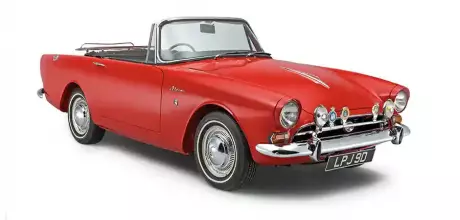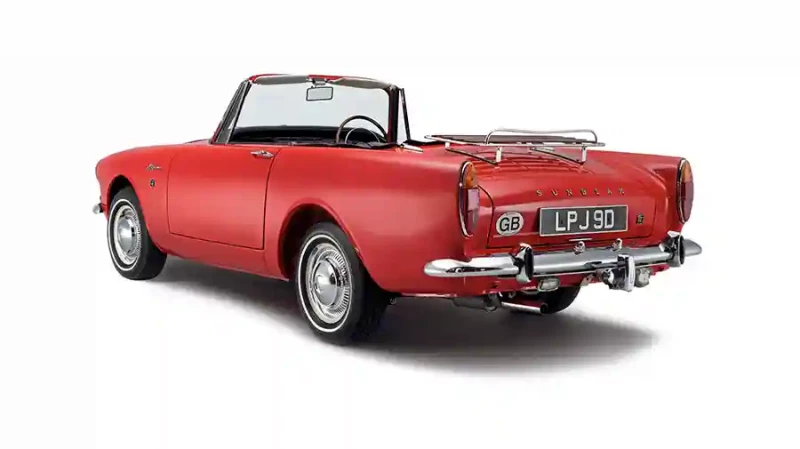Buying Guide Sunbeam Alpine

This unusual, handsome MGB alternative is outstanding value and a refined tourer – you’ll own a satisfying, reliable classic if you buy carefully. Here’s how to achieve that.
Words JESSE BILLINGTON
Photography JON COLLEY
Sunbeam AlpineBuying Guide
How to get yourself a bargain Sunbeam Alpine for less than £10k

Is there really such a thing as a classic bargain in today’s market? There’s a very good argument for the Sunbeam Alpine roadster meriting that description. The Rootes-built two-seater is rarer than a Triumph TR4 and cooler than an MGB – don’t forget, James Bond drove one in Dr. No – yet you can still land a great example for a fourfigure sum. That’s certainly not something that can be said of most Sixties icons.
The Alpine is a stylish sports tourer rather than an out-and-out sports car: think of it as a cutprice Mercedes Pagoda SL or Aston Martin DB4 Convertible and it’ll really start to make sense. It’s an enjoyable means of eating up the miles too, with solid, tidy handling thanks to Hillman Husky underpinnings. And there’s more good news: Alpines are tough, spares supply is excellent and they’re cheap to run – provided, of course, that you buy a tidy one to begin with.
We spoke to the Sunbeam Alpine Owners’ Club, Jerome Senn of London specialist Alpine Innovations, and Leicester-based Sunbeam Supreme to help you in your quest to do just that.
Which one to choose?
- Launched in 1959, the new ‘Series’ Alpine replaced the ‘Mark’ Alpine of the Fifties. Built on a Hillman Husky floorpan, it used Sunbeam Rapier running gear and a 1494cc engine.
- Coachbuilder Harrington offered a coupé version from late 1959.
- Series II Alpine of 1960 featured an optional removable hardtop and a 1592cc engine. Harrington fastback raced at Le Mans, winning its class in 1961, with the road cars being named Harrington Le Mans and featuring a rear-end restyle removing the tailfins. The 1963 Series III split the model range in two: the GT, with removable hardtop and no hood; and the soft-top 2+2 ST.
- 1964 Series IV had restyled rear with smaller tailfins, and optional automatic gearbox. Concurrent Harrington coupé named the C-type.
- 1965 Series V powered by 1725cc engine. Automatic option dropped. Harrington D-type featured hatchback rear luggage access. Harrington went bust in 1966. Alpine Series V was replaced by new Rapier fastback coupé in 1968.
Bodywork
Most Alpines will inevitably have some rust somewhere. The most important check is of the sills, which are essential to the car’s strength: you should ensure that all three layers of the sill are present and in good condition. It’s tricky to tell if any sill work has been done without taking the car to pieces, so ask to see photographic evidence or receipts. Sills are supposed to be curved to match the convex profile of the door above; cheap replacements are straight and don’t look right. Any water that gets past the leading edge of the sills will soon begin wreaking havoc.
Expect rust around the headlamps and along the base of the windscreen. The hinges also wear, allowing the door to drop; doors can also corrode along the front edge and underside. If the door has been reskinned, confirm that the rubber seal is there and that the profile of the whole door is correct – it often isn’t. Check the back of the car, particularly the base of the wings, which should have a drain hole visible. If this is absent, it’s a sign of a poor-quality repair. Also analyse the inner rear wheelarches: open the boot to inspect the rear corners of the boot floor and while you’re there make sure the trailing edge of the boot lid isn’t riddled with rot.
Always keep in mind that a full-body restoration isn’t really economically viable unless you’re looking at a Harrington Le Mans or a car with period competition history. A full restoration from a rusty bodyshell can easily absorb more than £25,000 if it’s carried out professionally.
Floorpans corrode badly, so be sure to pry under the carpets. The leading edges are prone to rusting through, especially around the accelerator pedal. Rear spring hanger mounting points behind the front seats are set on an angled panel – finding rust here may be the start of something worse.
Hardtops on earlier cars had aluminium tops that are fairly problem-free; later steel ones rot and the Perspex windows craze.
Engine
Oil leaks are common because the engines utilise a scroll-type oil seal, but a more modern one costs about £100 and can be fitted as part of a full engine rebuild (budget about £2000). Crankshaft pulleys also wear and eventually need replacing at a cost of about £200 for parts and fitting.

Generally, though, Alpine engines can cope with 130,000 miles between rebuilds if they aren’t neglected. Expect oil pressures of 15psi or 25psi respectively for the three- and five-bearing engines at idle; 50-55psi or 45psi at 2000rpm. Hardened valve seats are needed to run on unleaded fuel.
Overheating through neglect is the most common issue that befalls the engines, although the alloy cylinder heads can warp if they haven’t been torqued down properly after replacement. If the anti-freeze mixture isn’t changed at correct intervals to ensure the corrosion inhibitors are still effective, water passages can suffer corrosion build-up, reducing their efficiency. Another potential issue is the cylinder block cracking along a fault line in the water jacket, which can result if the coolant has been allowed to freeze.
Holbay tuning options were available for these engines in period, but they’re rare and expensive now and in reality don’t add much performance. A cheaper and more effective route to 100bhp is with Weber 32/36DGV carburettors in place of the original Solexes or Strombergs, on an Alpine Innovations manifold currently costing £933.37 plus fitting.
Gearbox
Rebuilding and reconditioning an overdrive gearbox costs about £1000. You can’t just stick a Hillman Hunter unit in, because it doesn’t fit. Regardless of an overdrive being fitted, a 3.89:1 back axle was fitted behind the four-speed manual gearbox.
Gearbox parts aren’t hard to find, but overdrive units are. Even those that need restoring will cost £500, and you’ll need to spend another £360 for a specialist to rebuild it. And there’s no Hunter easy solution here either – its overdrive unit won’t fit. There was an automatic Alpine, but it was only available on the series IV. The Borg Warner type 35 is reliable if you stay on top of the six-year fluid replacement intervals; and the fact that it’s shared with other classics eases parts availability.
Steering and suspension
Steering boxes have a habit of leaking, and idler assemblies wear and can seize. Everything is available to keep the steering sharp, so overhauling the system is straightforward. If wire wheels are fitted, inspect them for broken spokes and worn splines (jack the car up and rock each wheel). Early Series V cars’ self-adjusting rear brakes weren’t in production for long, and the system later reverted to the manually adjustable set-up from the Series I-IV.
All Alpines use semi-trailing arm rear and Macpherson-strut front suspension but there were a few changes along the way. Series I-IIIs use trunnions and kingpins that need regular greasing so it’s worth checking for records of this work. Many cars miss this, resulting in worn kingpins and sloppy handling. Series IV-V cars’ Metalastik bushes are excellent but will likely need replacing; polyurethane ones are about £20 each.
Bear in mind that, on an Alpine, the gap between the tyre and the wheelarch should be consistent. If it’s narrower at the top, it’s a sign of sagging springs.
Interior and electrics
Just about everything is available either new or reconditioned, although for much of the interior trim you’ll now need to rely on remanufactured items rather than new-old stock. Rubber mats are no longer available, but most owners now prefer to have carpet versions anyway.
From September 1965, the dynamo was replaced by an alternator, which feeds a regulator/warning lamp relay mounted on the inner wing. If the alternator is overcharging, these ancillaries will soon become damaged and cost you £140 to replace, so it’s worth pre-emptively checking the alternator’s output to make sure it’s working correctly.
‘On an Alpine, the gap between the tyre and the wheelarch should be consistent’
Below: large rear fins were shortened from 1964 Series IV onwards.
Right: remanfactured trim parts help keep interiors looking original. Engines are simple and tough. Later 1725cc units cope best with modern traffic. Alpines evolved a lot over nine years; early ones aren’t necessarily the most sought-after.
‘Rarer than a Triumph TR4 and cooler than an MGB, you can still get a great example for a four-figure sum’
What to pay
- There’s no real price difference between series, although Series III-V cars are considered most desirable. You may find a usable example for £4k, but nearer £5k is a more realistic start point.
- Most goodcondition Alpines tend to be sold for £8k-£12k.
- Show-worthy convertibles start at £13k, with the best making £17k.
- Rare Harrington coupés can be had from £15-£20k, rising to £30-£35k if mint.
- Anything with period competition history is on another level: think £45k-£70k.
1967 SUNBEAM ALPINE — £16,500
Seller’s description reads: ‘Sunbeam Alpine 1967 with Holbay 1725 engine (twin Weber carburettors), in excellent condition throughout. This car was restored and resprayed some years ago: photos, history and bills going way back. It has always been well looked after. It has overdrive, sounds good, goes well and has absolutely no problems. Everything works as it should except the clock. The interior and hood are excellent and it has a good tonneau and a hood cover. All good tyres and a new HD battery. The bumpers are okay but would benefit from rechroming.’

